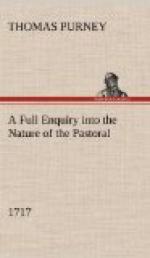Another Observation I would make, is, that a Pastoral Writer should be particularly careful not to proceed too far, or dwell too minutely on Circumstances, in his most pleasurable Descriptions, which we may term the Luscious. Such as Spencer’s, where he makes his Knight lye loll’d in Pleasures, and Damsels stripping themselves and dancing around for his Diversion. This, SPENCER methinks carries to an excess; for he describes ’em catching his Breath as it steam’d forth; distilling the Sugar’d Liquor between his Lips, and the like. Such Descriptions will grow fulsome if more than just touch’d, as the most delicious things the soonest cloy.
CHAP. IV.
That Pastoral should Image almost every thing.
There is nothing more recommends the Tragedys of Mr. Row, than his Language, which I think is (in it’s own Nature) particularly Beautiful.
As I cannot forbear looking into the Springs and Means by which our best Poets attain their Excellence in the several Dialects they touch the finest, what ’tis that constitutes the Difference between the Language of one and that of another; and also what Rank or Class each Dialect belongs to; I have done the same as to the Writings of Mr. Row. And I observe that the chiefest Means he makes use of to render his Tragick Language at once Uncommon and Delightful, is the Figurative Way of considering Things as Persons. What I mean is this.
——Comfort
Dispels the sullen Shades with her sweet Influence.
And again:
——My
wrongs will tear their Way,
And rush at once upon thee.
Jane Shore: Act 1.
And this is extreamly frequent, especially in Jane Shore. And nothing can be more Beautiful in Heroick Language; and this Author has some Sentiments dress’d, by this Figurative Way, as finely as most of Shakespear’s; As this
Care only wakes, and moping Pensiveness;
With Meagre, discontented Looks they sit,
And watch the wasting of the Mid-night Taper.
Now what is this but imaging almost every thing, or turning as many Thoughts as possible into Images?
Now if the Thoughts in strong Lines, (as they call ’em) appear best in Imagery, how much more will Pastoral Thoughts. The former have Passion and Heat to support ’em, the latter are entirely Simple. And If Heroick Writers are fond of Images, how much more should Pastoral Writers avoid a long Series of bare Thoughts, and endeavour to Address the Mind of the Reader with a constant Variety of Pictures.
What I have here delivered may seem trifling to the Reader. But if he looks into the modern Pastoral-Writers he’ll observe that the Scarcity of Images goes a great way towards making their Pieces flat and insipid. And ’tis impossible indeed to have a sufficient Variety of Images in a Pastoral that is compos’d by nought but a mournful Speech or Complaint. Therefore a Writer who would not only write regular, but also delightful Pastorals, should doubtless run very much upon Description.




